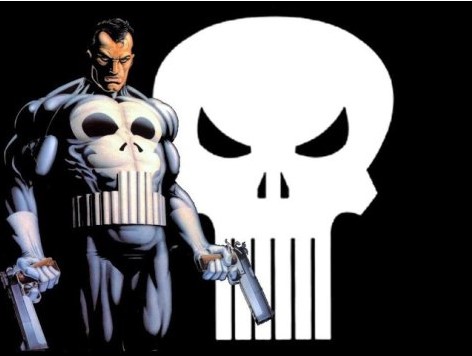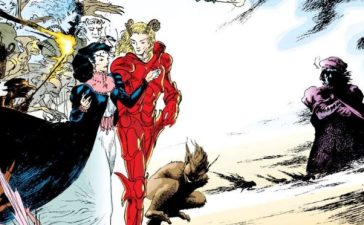Marvel Comics character The Punisher first appeared in The Amazing Spider-Man #129 (cover-dated February 1974). Created by writer Gerry Conway (with input from publisher Stan Lee, who suggested the character’s name) and artists John Romita, Sr. (who tweaked Conway’s design for the character, specifically putting a large skull symbol on the character’s chest) and Ross Andru (who first drew the character for publication), The Punisher was initially an antagonist to Spider-Man; as a vigilante, The Punisher is relentless in killing criminals, which puts him at odds with Spider-Man and other Marvel superheroes. However, over the years, the character evolved into a sympathetic antihero that remains popular with many comics fans. It appears that some of those fans are in the United States Armed Forces.
The Punisher is Frank Castle, a Marine Corp veteran with Special Forces training; his family – after they witness a Mafia execution in New York City’s Central Park – is killed by mobsters. To avenge his family, Castle becomes a vigilante who kills criminals; he wears a black costume with a large white skull symbol emblazoned on his chest. Unlike other costumed comics characters with superpowers or specialized non-lethal weapons, The Punisher uses handguns, sniper rifles, grenades, knives, and sometimes his bare hands to stop criminals – permanently.
The Punisher is one of Marvel’s most popular characters. In the 1990s, The Punisher starred in three ongoing comic book titles (The Punisher, Punisher War Journal, and Punisher War Zone); it’s rare for a character to headline multiple, concurrent ongoing titles, with Superman, Batman, and Spider-Man as examples of the few other popular comics characters to do so. The Punisher is also the protagonist of multiple films – The Punisher (1989), The Punisher (2004), Punisher: War Zone (2008), and the fan film Dirty Laundry (2012).

The Punisher’s popularity among United States military personnel is evidenced by the incorporation of the character’s distinctive skull symbol into artwork generated within the military, most notably by the United States Navy’s Sea, Air, Land Teams (“Navy SEALs”) and the United States Army’s 24th Infantry Regiment. There is a long tradition – dating back to colonial times – of American military personnel using skull imagery in officially unauthorized-but-allowed insignia artwork. The Punisher’s fans in the military continue this tradition with the creation of unit insignia based on the character’s skull symbol.

The 24th Infantry Regiment’s “Deuce Four Skull” insignia is clearly based on The Punisher’s skull symbol. The 24th Infantry regiment was deployed to Iraq as part of Operation Iraqi Freedom in 2004, and the “Deuce Four Skull” was painted on the walls of buildings where the regiment killed enemy combatants; the symbol became a fearsome calling card for the regiment.

The Navy’s SEAL Team 3 paints The Punisher’s skull symbol on its military gear. Reporting on former SEAL Team 3 sniper Chris Kyle (who claimed to have made 255 kills, which would make him the most lethal U.S. sniper in history), the Daily Mail notes that for SEAL Team 3 the “action was enough that the members of the unit adopted the white skull of the gun-wielding comic book vigilante The Punisher. They painted the symbol on their body armor, their vehicles and even their weapons.” The New Yorker, reporting on Kyle’s death, also notes the use of The Punisher’s skull symbol by SEAL Team 3: “Kyle seemed to consider himself a cross between a lawman and an executioner. His platoon had spray-painted the image of the Punisher—a Marvel Comics character who wages ‘a one-man war upon crime’—on their flak jackets and helmets.” Kyle liked the skull symbol so much that he incorporated it into the logo of his company Craft International, which provides tactical training for military and law enforcement personnel.

The Punisher has many fans, but given the incorporation of his skull symbol into military artwork, it’s unlikely that the character is appreciated by America’s enemies.









